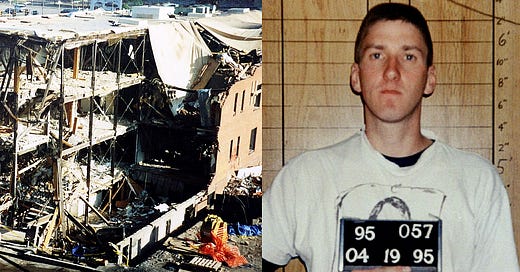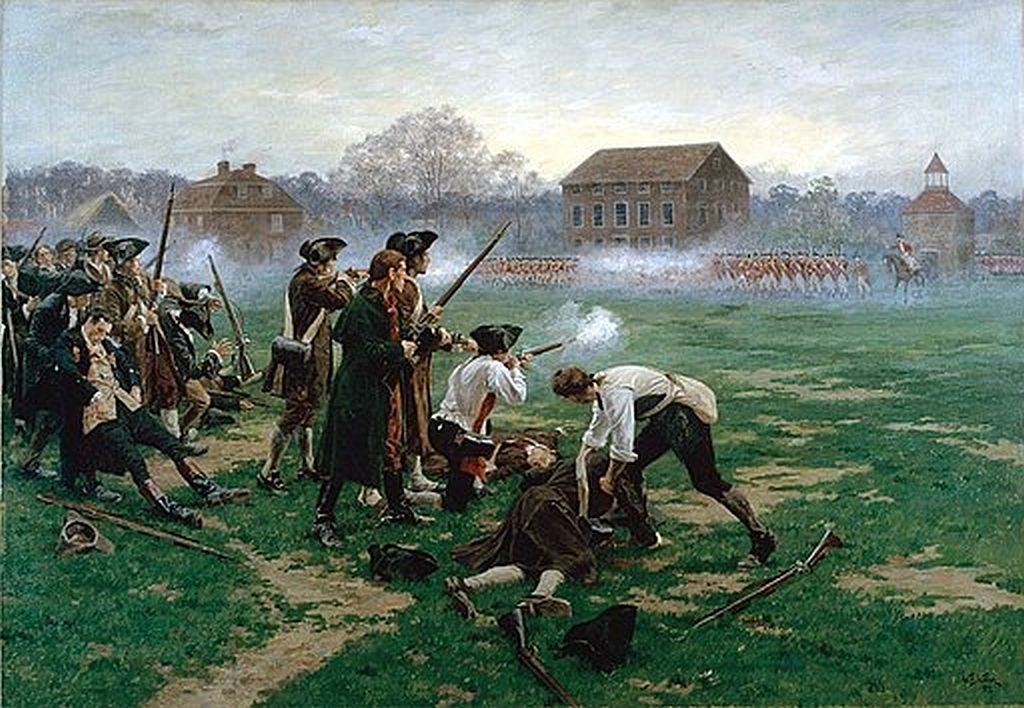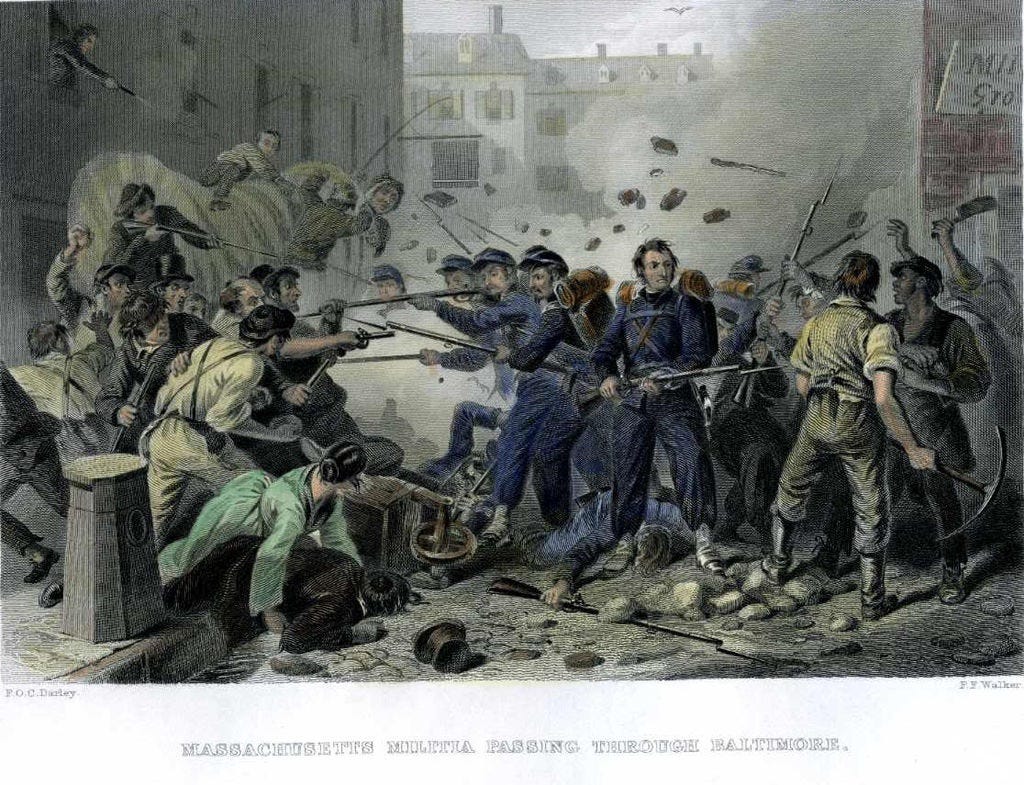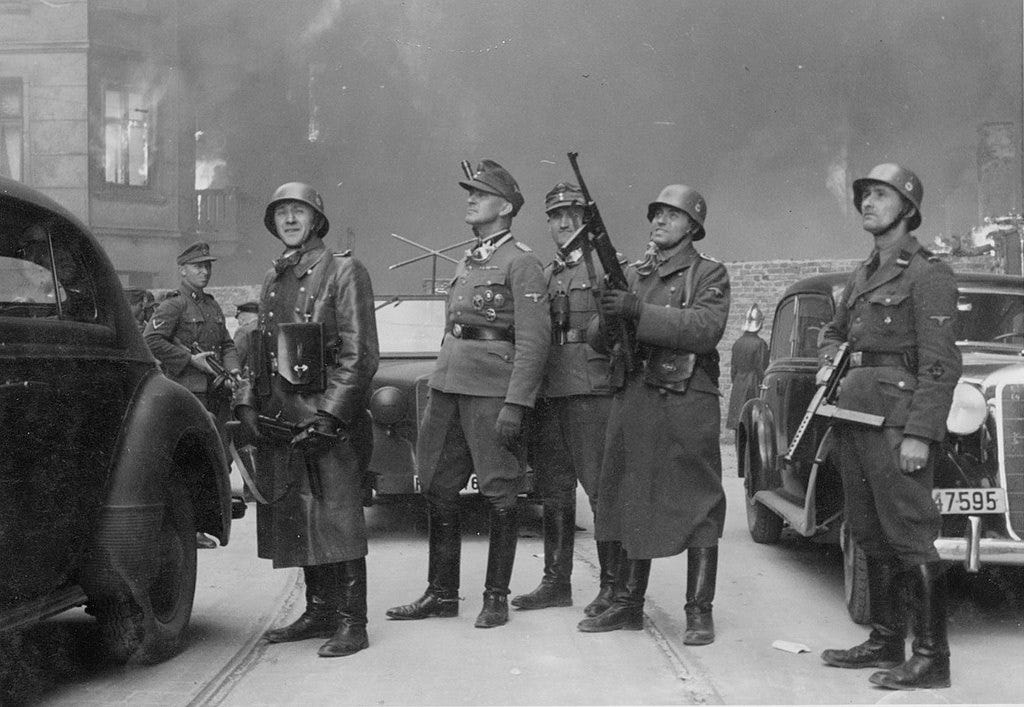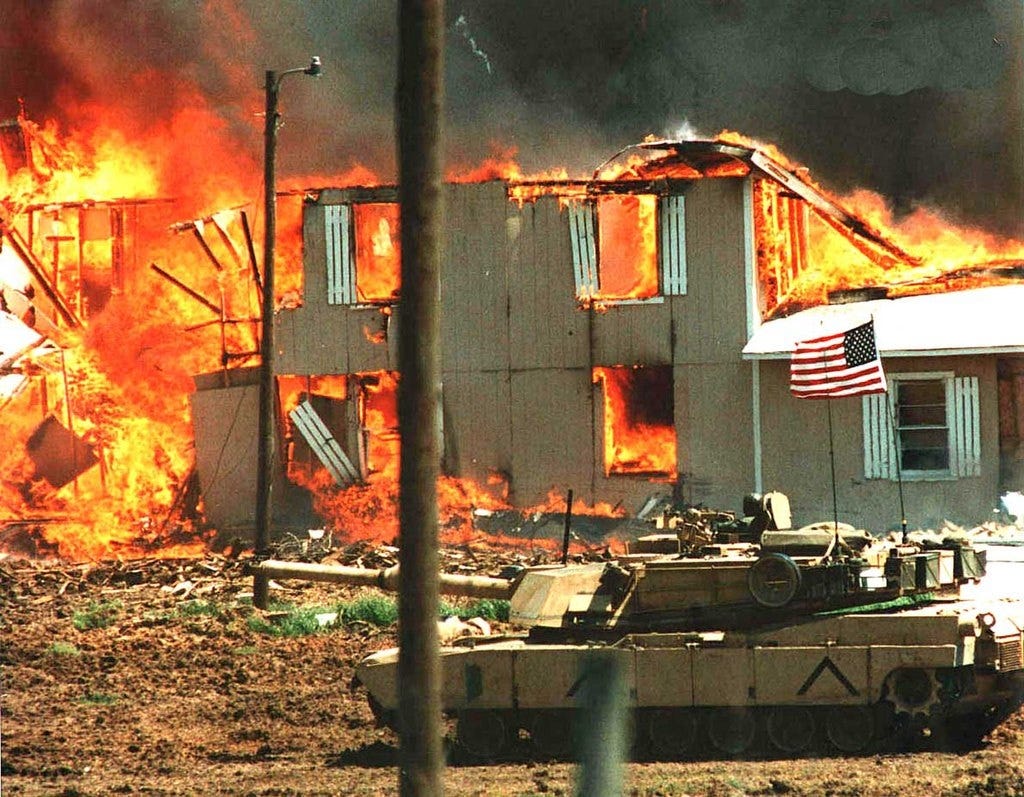The Mysteries of History (April 19 Edition)
Revolutionary War Begins; First Civil War Murders; Warsaw Ghetto Uprising; Waco Fire; Oklahoma City Bombing
“Those who cannot remember the past are condemned to repeat it.” — Spanish-American philosopher George Santayana, 1905
1775 — Revolutionary War Begins
public domain image from wikimedia commons
When the British arrived in Lexington, Massachusetts, on this day in 1755, the local Patriot Minutemen were vastly outnumbered. So, when the British Major ordered them to disperse, they began to do so, but somebody unknown to history (us) fired a shot at the British. This caused a like response from the foreign invaders, and the brief battle ended with eight dead and ten wounded Americans, and one British soldier wounded. A rather ignominious beginning for the locals, but it was the beginning of the Revolutionary War, the “shot heard ‘round the world” by a mystery hothead or braveheart.
From there, though, the tide turned. The British went on to Concord, where a larger group of Militiamen surrounded them. The British leader decided discretion was the better part of valor and beat a retreat. On the march back to Lexington, they were shot at by guerilla warriors using trees, rocks, and fences as hiding spots/defensive fortifications. Then when they quickly marched through Lexington, they lost several more men at the hands of the regrouped Lexingtonians.
By the time the day was done, the British had lost almost 300 soldiers, whereas the Americans had lost fewer than 100.
For more on this, see the article 1775 — Revere, Dawes, and Prescott Warn and Rally the Minutemen in yesterday's post here.
Questions: How many of the British soldiers, percentage-wise, do you think sympathized with the Americans? How many Americans were internally divided over whether to stay loyal to England or cast their land with the nascent new Nation about to be born? What reception did the British soldiers get when they returned to Boston? How much longer did they remain in Boston?
1861 — First Murders of the Civil War
public domain image from wikimedia commons
Four score and six years after the “shot heard ‘round the world” in 1775, in Baltimore, Maryland, local secessionists attacked a group of soldiers from Massachusetts on their way to Washington, D.C. They picked a fight with the wrong folks, though, as they killed four soldiers but a dozen of them lost their lives.
These were the first deliberately caused deaths of the Civil War, as the attack of Fort Sumter in South Carolina a week earlier did not result directly in the deaths of anyone (a couple were killed in accidents, but none on either side by a personal act of violence against them.
Baltimore police, although perhaps sympathetic towards the mob, came to the assistance of the soldiers.
Thereafter, Baltimorean rebels tore down bridges and telegraph poles linking their city to the Nation’s Capital in order to put a kink in the Union’s war efforts. By no means were all Marylanders treasonous, though: The Old Line State never seceded from the Union, and it provided more Union soldiers (50,000) than volunteered for the Confederate rabble (22,000).
Questions: Is there any indication where former Baltimorean Edgar Allan Poe’s (1809-1849) sympathies would have been had he still been alive when the Civil War broke out? Had the policemen been off duty, would all of them have willingly come to the aid of the soldiers from Massachusetts? Did Baltimore Orioles (the birds, not the baseball team, which didn’t exist until 1954) take sides in the conflict?
1943 — Warsaw Ghetto Dwellers Fight Back
public domain image from wikimedia commons
The Jews in Warsaw, Poland, were relegated to a section of the city known as the Warsaw Ghetto. This wasn’t a ghetto in the American parlance (a place where poor people lived); it was in effect a concentration camp within a city, surrounded by barbed wire and SS guards.
Every month, six thousand of the Jews in the ghetto were being transported to another, even worse, concentration camp in Treblinka. The Nazis told those still in the Ghetto that those being taken away were going to work camps. The residents of the ghetto eventually found out the truth, though, that those who were spirited away were being exterminated. Knowledge of this provoked the creation of an underground resistance movement. A limited number of guns were smuggled in (at high cost) for their use. Earlier in the year, the resistance fighters successfully inflicted casualties on the Nazis who entered to kidnap some of the Ghetto dwellers. The battle lasted for days, and the Nazis finally skedaddled.
On this date, though, the Nazis came back in force (with 1,000 soldiers, tanks, and heavy artillery) with the plans to completely empty the ghetto as a sort of birthday present to Hitler. The resistance group defended themselves with the weapons they had (the guns, as well as homemade bombs) on this date in 1943. This became known as the Warsaw Ghetto Uprising.
When the Nazi forces arrived, tens of thousands of the Jews hid in secret bunkers. Those who confronted them were a valiant but relatively small group of one thousand. The Germans temporarily withdrew after suffering some casualties, but came back stronger and more determined five days later, on April 24th. By the middle of May, the Nazis had taken complete control of the Ghetto, and resumed sending the surviving residents of the ghetto to the concentration camp in Treblinka 66 miles away.
Three hundred German soldiers died in the uprising. Thousands of Jews were killed. And of those left, who were then railroaded out of town to the even harsher conditions that awaited them in Treblinka, only a few survived until the end of the war.
Questions: Why did it take the Germans three months to re-enter the Warsaw Ghetto after retreating in January? Why were they still not fully prepared for the resistance they would face when they returned on April 19th? Did the Ghetto dwellers receive any support from the Polish residents of Warsaw or other parts of the Country?
1993 — Branch Davidian Compound Burns
public domain image from wikimedia commons
The following is what I wrote about the Waco incident in my book Still Casting Shadows: A Shared Mosaic of U.S. History — Volume 2: 1914-2006:
BATF (The Bureau of Alcohol, Tobacco, and Firearms, a branch of the U.S. Treasury Department) and FBI agents raided the seventy-seven acre Branch Davidian compound outside Waco, Texas in the spring of this year, investigating reports of a stockpile of illegal arms, as well as child-abuse allegations. When the ATF unit moved in on February 28th, the Branch Davidian members resisted by using some of their stockpile of weaponry. Four ATF agents were killed in the exchange, as were six members of the Branch Davidian community. The cult’s leader, David Koresh (real name Vernon Howell), was among the wounded.
Howell had adopted the name David Koresh for its Biblical symbolism: Koresh is the Hebrew name for “Cyrus,” the Persian King who had destroyed Babylon twenty five hundred years earlier. Howell apparently viewed modern society as a new “Babylon” and presumably saw himself as the future conqueror of such.
The “Branch Davidians,” as they were called (they didn’t normally refer to themselves by that name) had actually broken off from the Seventh Day Adventists in 1934 and had been living at “Mount Carmel,” as they called their compound located outside Waco, Texas, for almost sixty years at the time of the raid. The unwanted attention from the authorities came about when a UPS driver noticed grenade hulls and black powder in a shipment of boxes he was delivering to their compound, which had accidentally broken open while in transit. The alarmed driver contacted the local police, who then got in touch with the BATF.
It was believed that the residents of the compound were producing machine guns and grenades. The initial raid was made in order to search for evidence of illegal activity and to arrest David Koresh. One of the few survivors of the siege claimed that Koresh had invited the government to come and inspect their operation, which was supposedly a legal and above-board gun dealing operation which the group carried out at gun shows. Rather than accept the invitation, the government forced their way in, upon which the aforementioned gun battle ensued.
Those who defended the rightfulness of the raid cited the following as just cause for doing so: The Davidians were regularly receiving large shipments of gun parts and other materials that could be used to manufacture illegal weapons (they were not federally licensed gun dealers, nor did they possess machine gun licenses). During 1992 alone, the group had received hundreds of weapons and thousands of rounds of ammunition, including parts for M-16s and AK-47s, grenades, a grenade launcher, and explosives. Suspicious at least was their practice of posting armed guards at their compound, who were told by Koresh to “shoot to kill” in the event that intruders were to infiltrate Mt. Carmel.
One possible reason for this fearful attitude toward outsiders on the part of the Davidians was that the former leader of the group, George Roden, had threatened Koresh, who had taken over leadership after a gunfight between the two factions. Koresh was also the regular recipient of hate mail from friends and relatives of members of his “flock.”
The legal basis behind the pursuit was that the gun activity in which the group was involved was deemed illegal. In order to own a machine gun, one must pay a $200 tax and fill out requisite paperwork. So it was a matter of registration and taxation. The basic issue contained elements similar to the Ruby Ridge incident (see the 1992 chapter) and the Whiskey Rebellion (see the 1791 chapter).
Koresh seemed to have more in common with fellow gun lover Randy Weaver than with the farmers of old Pennsylvania, though: He showed members gory footage of the Vietnam War and called these “training videos.” A former member of the group, a Registered Nurse, claimed that Koresh had fathered at least fifteen children from various women and girls in the com pound—some of them as young as twelve years old. This nurse says that she delivered seven of these babies herself, and that Koresh annulled the marriages of members of his church and then gained sole sexual access to all the women.
From the more cynical camp of observers (those critical of the government, that is) came the charge that the raid was carried out due to—or at least timed so as to closely precede—an upcoming Congressional decision regarding BATF funding. Newsman Mike Wallace reported that most of the BATF agents he had interviewed called the raid a “publicity stunt.” After all, the BATF, as well as their partners in crime-fighting, the FBI, were still smarting from the PR bruising they had received after the debacle in Ruby Ridge.
David T. Hardy, a former U.S. Department of the Interior headquarters staff attorney, wrote a book entitled This Is Not an Assault: Penetrating the Web of Official Lies Regarding the Incident at Waco. In it he writes:
The ATF desperately needed publicity. It was reeling from a 60 Minutes series on sexual harassment (indeed, near-rapes) of female agents, stinging from a racial dis crimination class-action lawsuit (which it soon lost), and was only ten days away from its appropriations hearings in the House of Representatives. Internally, agents were referring to the Waco raid as “ZBO,” slang for “Zee Big One,” the publicity stunt that would ensure the agency went into the hearings with headlines and national media coverage behind it. A quiet arrest in the countryside would not make for ZBO.
After the initial raid, additional BATF and FBI forces arrived on the scene, bottling up the members inside their compound. Various forms of “persuasion” were utilized to undermine Koresh’s influence on the residents of Mt. Carmel: The FBI played statements of former members over loudspeakers, and they sent into the compound videotapes and pictures of members’ children, as well as messages from family members. Their intent was to increase the flow of the exodus from the compound from a trickle to a flood—Koresh apparently allowed any who chose to depart to do so at any time they wished.
Perhaps even more disconcerting were the recordings of Tibetan chants, Christmas music, and the screams of rabbits being slaughtered which the FBI blasted over loudspeakers aimed at Mount Carmel. During the nights, a weapon of psychological warfare wielded was floodlights that served to disrupt the sleep of those involuntarily basking in their eerie glow.
Feeling the Mt. Carmelites were too comfortably ensconced in their collec tion of buildings, the feds shut off electrical power to the compound, and sur rounded their quarters with “concertina wire” (spiral barbed wire) fencing.
If the authorities had really wanted the group to surrender, as they claimed they did, one would think they would have wanted the people inside to be thinking straight and clearly, but this strategy was not conducive to such a state of mind. In addition to the previously mentioned tactics, they increas ingly tightened the perimeter around Mt. Carmel, creating a shrinking con centric circle of concentrated power: Armored vehicles of various types, as well as a massive display of weapons and personnel.
Harvard Psychiatry and Law Professor Alan A. Stone wrote that these con ditions caused a “constant stress overload…intended to lead to sleep-depriva tion and psychological disorientation…and emotional chaos.” Stone also complained about the CS gas used by the FBI, which is known to be harmful, especially to children—the group of people inside the compound the govern ment claimed to be most concerned about protecting.
In fact, it was later determined that the average concentration of CS gas inside Mount Carmel during the attack was 10–90 times that required to deter trained troops—enough to overcome protective masks. The suffering was all the worse in the case of children.
Most of the twenty-four children who died on April 19th did so of suffocation. Many of these deaths were from smoke inhalation, but some may have been a result of the CS gas. The cause of the fire is also disputed, both sides blaming the other for the ignition of the conflagration.
Helicopters were also used to—if you believe one side—simply observe the goings-on in the compound, or—if you believe the other side—fire on the res idents of the compound from above. Some say these shooters were govern ment law enforcement agents, others (including a CIA agent) claim they were in fact members of the military’s secret Delta Force Unit. It is illegal for the government to use the military in police matters.
Due to the way they had been terrorized, many of those holed up in Mt. Carmel may have been afraid to go out into what they may have reasonably foreseen as a Butch Cassidy and the Sundance Kid-like hail of bullets/blaze of gory “glory.”
The initial siege had lasted two hours. The final one, fifty-one days later, on April 19th, was much more chaotic and catastrophic. The FBI, fearing their team would lose its edge if they had to wait any longer, decided it was time to act. The orders came from above: President Clinton conferred with Attorney General Janet Reno, but told her it was ultimately her decision. Clinton’s delegation of this decision was not due to any ambiguity in his mind about the bent of the Branch Davidians and their leader. Clinton later said, “Koresh’s response to the demands for his surrender by federal agents was to destroy himself and murder the children who were his captives, as well as all the other people who were there who did not survive.”
Clinton also went on record as being convinced that the Davidian dead had committed suicide: “I was, frankly, surprised would be a mild word, that anyone would suggest that the Attorney General should resign because some religious fanatics murdered themselves.”
David Thibodeau, one of the few survivors of the raid, claims that their gun operations were a legal money-making venture, and that Koresh had invited the BATF to come and examine the weapons weeks prior to the initial raid. Thibodeau also asserts that Koresh was going to surrender to the authorities once he completed the writing of his interpretation of the Seven Seals of Rev elation. The feds thought this was just another ploy (Koresh had earlier indi cated he would surrender, but had reneged on those promises).
Two completed commentaries written by Koresh were discovered in the ashes of Mount Carmel in the inferno’s aftermath. Probably nobody knows for certain whether Koresh would have really “come out with his hands up” after completing the full complement of manuscripts. One may wonder, though: If Koresh intended to “go quietly,” why could he not have written the documents while in custody?
According to Thibodeau, all who were inside wanted to live. Differing with the nurse who had been a member, he also denies the child abuse charges.
The FBI began pumping CS (tear) gas into the compound several hours prior to the fatal fires breaking out. Thibodeau, who co-authored a book with Leon Whiteson named “A Place Called Waco: A Survivor’s Tale” wrote con cerning this:
The noxious CS gas that the FBI shot into Mount Carmel (almost 400 rounds were fired at us) was mixed with methylene chloride, which is flammable when mixed with air and can become explosive in confined spaces. CS gas is so nasty that the United States, along with 130 other countries, has signed the Chemical Weapons Convention banning its use in warfare. But apparently there is no prohibition against its use against American citizens.
It could be that many who may have wanted to escape found it impossible to do so—they might have been prevented from doing so due to being trapped by the fire and building damage, or possibly even lost consciousness as a result of the massive amount of gas infused into their quarters.
The Davidians did, as during the initial siege, fight back on April 19th. When the tear gas was “inserted” (in the euphemistic terminology of the gov ernment), the Davidians fired back. The fire, which led to most of the deaths, was either deliberately set by the Davidians in a pre-arranged mass suicide (according to the government’s story) or touched off by the ramming of the building by one of the tank-like vehicles, knocking over a lantern (which the Davidians were using for light and heat, since their electricity was shut off). According to Thibodeau, the latter was the case.
Why did the Davidians have such a supply of kerosene laid up, though? It seems unlikely that they anticipated the authorities would shut off their elec tricity—the outrage they displayed when it occurred makes it at least appear they were not expecting it.
Thibodeau wrote of what it was like for those inside Mount Carmel during the attack:
It remains hard for me to clearly remember what happened after the tanks made their move. Walls collapsed, the building shook, gas billowed in and the air was full of terrible sounds: the hiss of gas, the shattering of windows, the bang of exploding rockets, the raw squeal of tank tracks. There were screams of children and the gasps and sobs of those who could not protect themselves from the noxious CS. This continued for hours. Inside Mount Carmel, the notion of leaving seemed insane; with tanks smashing through your walls and rockets smashing through the windows, our very human reaction was not to walk out but to find a safe corner and pray. As the tanks rolled in and began smashing holes in the building and spraying gas into the building, the FBI loudspeaker blared, “This is not an assault! This is not an assault!”
Around noon I heard someone yell, “Fire!” I thought first of the women and children, whom I had been separated from. I tried desperately to make my way to them, but it was impossible: rubble blocked off passageways, and the fire was spreading quickly. I dropped to my knees to pray, and the wall next to me erupted in flame. I smelled my singed hair and screamed. Community member Derek Lovelock, who had ended up in the same place as me, ran through a hole in the wall and I followed. Moments later, the building exploded.
As millions watched the shootout and inferno on live television, upwards of seventy people died inside the compound. Of the eighty-three members trapped inside the blazing inferno, Thibodeau was one of only nine who sur vived.
Quoting from an article the aforementioned David Hardy wrote, entitled “Call It Off ”:
During the siege, Davidians told FBI negotiators that the double doors were the best evidence of who fired first: The bullet holes through the left one were all pointing inward. After the fire, the left door (which, it should be stressed, was made of sheet metal, not wood) simply vanished. Although the scene was sealed off to all but the ATF and the FBI, divided into squares and searched as if it were an archaeological site, the left door somehow went missing and remains so to this day.
Two clues point to its fate. First, the soundtrack of an FBI video picked up radio transmissions as the fire was burning down: They reveal “T-1” asking: “Shall we begin taking this place apart?” Second, Jim Brannon, attorney for some of the Davidian survivors, located a home video made by one of the fire department per sonnel as the fire died down. This shows agents backing up a rented moving truck to the ruins and hastily loading a door-sized object, wrapped in black plastic, into it.
The evidence, in short, strongly suggests that the government knew the door’s bullet holes would incriminate the ATF as the initiator of the gunfight in front, and accordingly made its disappearance a high priority.
…
There is also a deeper question: Regardless of who started the fire, did the FBI deliberately initiate a chain of events which would cause one? Getting rid of the incriminating front door appears to have been a high priority. It would have been the most solid piece of evidence that the ATF began the gunfight, and coming after 51 days of government spokesmen blaming the Davidians, would have been stunning evidence that they were victims rather than cop-killers. The Davidians had been insisting that the door would prove them right and that the building bore bullet holes from above, as a record of the helicopters’ gunfire, as well. A fire provided the only convenient way of making the door and all the bullet holes in the walls vanish. A disastrous fire would, in short, be uncommonly convenient to the federal agencies.
Six years later, in 1999, the FBI admitted (reversing its previous vehement denials) that it had used pyrotechnics and incendiary tear gas cartridges during the final day of the siege. Precisely two years later, the Federal Building in Oklahoma City, Oklahoma was bombed. The perpetrators claimed they had carried out their carnage in retaliation for the government’s acts in Ruby Ridge and Waco.
Questions: How many days was the standoff? How much food and water did the Branch Davidians have (how long could they have held out)? How many of the Branch Davidians were killed? How many federal agents? How many of those killed were children?
1995 — Oklahoma City Bombing
[ Oklahoma City bombing/T. McVeigh image (as well as the picture of the kindle version of “Secret Lives of Kids” at end) elided due to the post otherwise being too long to be emailed ]
The following is what I wrote about the Oklahoma City Bombing in my book Still Casting Shadows: A Shared Mosaic of U.S. History — Volume 2: 1914-2006:
U.S. Army veterans Timothy McVeigh and Terry Nichols bombed the Alfred P. Murrah Federal Building in Oklahoma City on April 19th, on the two-year anniversary of the Waco/Branch Davidian disaster. One hundred sixty-eight people were killed (and another died while taking part in the rescue effort). Included in the dead were nineteen children who had been in the building’s day-care center on the first floor. The blast was strong enough that 220 buildings suffered damage.
A little over six years later, and three months before “9/11” (2001), Timo thy McVeigh was executed at the Federal Penitentiary in Terre Haute, Indiana, the first federal execution in almost forty years. His accomplice Terry Nichols is serving a life sentence for involuntary manslaughter (although it is difficult to understand why the results of their deed could be considered involuntary) and conspiring with McVeigh.
Even if you concur that various individuals from a few government agencies were culpable in the Waco and Ruby Ridge debacles, it is quite a challenge to puzzle out how bombing a federal office building—one which contained no military or secret service offices, but which did include a day-care center on the ground floor—could be considered a blow against tyranny, a strike in the cause of justice.
Besides the hundreds of people directly affected by the despicable and incomprehensible crime against humanity—that is to say, those killed and their family and friends—others too were seriously impacted. Among these “shadow victims” are both humans and animals.
The bomb exploded at 9:02 a.m. Within twenty minutes, police K-9 teams from Oklahoma City arrived on the scene. Within six hours of the blast, the first volunteer search and rescue teams from outside the area arrived. By midnight, the focus of the search had shifted from locating live victims to recovering bodies.
The search and rescue operation was extremely stressful for the seventy four dogs used in the effort as well as their handlers. It was no blitzkrieg type of operation, either. It lasted sixteen days, until May 4th. The locals remained, though. It was not until May 29th, a full forty days after the mass murder, that the last three bodies were recovered by two Oklahoma City Police Department patrol/search dogs.
In Susan Bulanda’s book “Ready to Serve, Ready to Save! Strategies of Real-Life Search & Rescue Missions,” in a chapter written by Marilyn Neudeck-Dicken, Ph. D., entitled “The Oklahoma City Bombing: What Have We Learned?” some of the problems the volunteers faced at the time and dealt with after the fact are detailed:
Handlers and dogs were exposed to a vast magnitude of trauma. The air was thick with fumes and debris for days. Dogs experienced exposure to chemical toxins, asbes tos, body fluids, eye irritants, and cuts, to name a few. Could the high incidence of cancer and blindness of the dogs who were in the first responding dog teams be a result of these exposures?…long-term ramifications of the bombing not only affected the dogs, but also the handlers as well.
Neudeck-Dicken, herself a search-and-rescue worker, goes on to relate some of the affects the disaster had on the rescue personnel who responded. Sixty-eight per cent of the dog handlers at Oklahoma City demonstrated acute stress reactions for over two years. Of the dog handlers who were not emergency personnel by occupation, 25% of them dropped out of Search & Rescue immediately after returning home.
This event brought home to Americans the realities of the new world in which they were now living: Terrorists could strike anywhere, anytime. Lest your faith in humanity be totally obliterated by vermin such as McVeigh and Nichols, though, note this excerpt from the chapter “Tragedy in the Heart land: The Oklahoma City Bombing” by Dewey H. Perks, taken from the book cited above:
The kindness extended by the citizens of Oklahoma was overwhelming…we were not ready for the manner in which they treated us. Being from Virginia we felt that we were very familiar with the mystique of “the genteel South” and its hospitality. Yet every time that we met the locals, they expressed their gratitude and concern that we should be careful. At first we interpreted this as a method to encourage us to work harder, but as the days wore on, we realized that they knew we were truly working as hard as we could. The citizens waited on us hand and foot and we actually had to be careful what we requested since anything we asked for was delivered. Besides having our meals supplied, a small support city evolved within the confines of the Myriad. This included podiatrists, opticians, masseuses, shipment anywhere by United Parcel Service, telephone service by Southwest Bell, and a barbershop. Each day there were new “hosts” in the center. These were people who just wanted to help or others who had family directly affected by the bombing.
For those interested in and/or willing to investigate “conspiracy” theories, former Oklahoma State Congressman Charles Key headed up the voluminous Final Report on the Bombing of the Alfred P. Murrah Federal Building, April 19, 1995 which—similar to the Columbine catastrophe’s alternate tellings—reports on an “olive-skinned man” who accompanied McVeigh and—similar to the conspiracy theorists reports of the 9/11 World Trade Center attacks—suggests that there was more than one explosion, and that some people knew in advance what was about to occur (some ATF employees were told not to come into work that day, and a bomb squad was already on alert in downtown Oklahoma City prior to the bombing, among other circumstantial and perhaps coincidental events).
Questions: Have you seen the Netflix documentary Oklahoma City Bombing: American Terror?
Read about “The Secret Lives of Kids” here.

